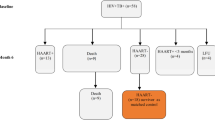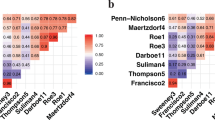Abstract
Owing to our lack of understanding of the factors that constitute protective immunity during natural infection with Mycobacterium tuberculosis (Mtb), there is an urgent need to identify host biomarkers that predict long-term outcome of infection in the absence of therapy. Moreover, the identification of host biomarkers that predict (in)adequate response to tuberculosis (TB) treatment would similarly be a major step forward. To identify/monitor multi-component host biomarker signatures at the transcriptomic level in large human cohort studies, we have developed and validated a dual-color reverse-transcriptase multiplex ligation-dependent probe amplification (dcRT–MLPA) method, permitting rapid and accurate expression profiling of as many as 60–80 transcripts in a single reaction. dcRT–MLPA is sensitive, highly reproducible, high-throughput, has an extensive dynamic range and is as quantitative as QPCR. We have used dcRT–MLPA to characterize the human immune response to Mtb in several cohort studies in two genetically and geographically diverse populations. A biomarker signature was identified that is strongly associated with active TB disease, and was profoundly distinct from that associated with treated TB disease, latent infection or uninfected controls, demonstrating the discriminating power of our biomarker signature. Identified biomarkers included apoptosis-related genes and T-cell/B-cell markers, suggesting important contributions of adaptive immunity to TB pathogenesis.
This is a preview of subscription content, access via your institution
Access options
Subscribe to this journal
Receive 6 digital issues and online access to articles
$119.00 per year
only $19.83 per issue
Buy this article
- Purchase on Springer Link
- Instant access to full article PDF
Prices may be subject to local taxes which are calculated during checkout






Similar content being viewed by others
References
Atkinson AJ, Colburn WA, DeGruttola VG, DeMets DL, Downing GJ, Hoth DF et al. Biomarkers and surrogate endpoints: preferred definitions and conceptual framework. Clin Pharmacol Ther 2001; 69: 89–95.
Bowtell DD . Options available—from start to finish—for obtaining expression data by microarray. Nat Genet 1999; 21: 25–32.
Lonnroth K, Castro KG, Chakaya JM, Chauhan LS, Floyd K, Glaziou P et al. Tuberculosis control and elimination 2010–50: cure, care, and social development. Lancet 2010; 375: 1814–1829.
World Health Organization. Global tuberculosis control epidemiology, strategy, financing. WHO Report, WHO, Geneva 2009.
Kaufmann SH . Future vaccination strategies against tuberculosis: thinking outside the box. Immunity 2010; 33: 567–577.
Schouten JP, McElgunn CJ, Waaijer R, Zwijnenburg D, Diepvens F, Pals G . Relative quantification of 40 nucleic acid sequences by multiplex ligation-dependent probe amplification. Nucleic Acids Res 2002; 30: e57.
Eldering E, Spek CA, Aberson HL, Grummels A, Derks IA, de Vos AF et al. Expression profiling via novel multiplex assay allows rapid assessment of gene regulation in defined signalling pathways. Nucleic Acids Res 2003; 31: e153.
White SJ, Vink GR, Kriek M, Wuyts W, Schouten J, Bakker B et al. Two-color multiplex ligation-dependent probe amplification: detecting genomic rearrangements in hereditary multiple exostoses. Hum Mutat 2004; 24: 86–92.
Bonecini-Almeida MG, Ho JL, Boechat N, Huard RC, Chitale S, Doo H et al. Down-modulation of lung immune responses by interleukin-10 and transforming growth factor beta (TGF-beta) and analysis of TGF-beta receptors I and II in active tuberculosis. Infect Immun 2004; 72: 2628–2634.
Demissie A, Abebe M, Aseffa A, Rook G, Fletcher H, Zumla A et al. Healthy individuals that control a latent infection with Mycobacterium tuberculosis express high levels of Th1 cytokines and the IL-4 antagonist IL-4delta2. J Immunol 2004; 172: 6938–6943.
Knudsen TB, Gustafson P, Kronborg G, Kristiansen TB, Moestrup SK, Nielsen JO et al. Predictive value of soluble haemoglobin scavenger receptor CD163 serum levels for survival in verified tuberculosis patients. Clin Microbiol Infect 2005; 11: 730–735.
Lienhardt C, Azzurri A, Amedei A, Fielding K, Sillah J, Sow OY et al. Active tuberculosis in Africa is associated with reduced Th1 and increased Th2 activity in vivo. Eur J Immunol 2002; 32: 1605–1613.
Jacobsen M, Repsilber D, Gutschmidt A, Neher A, Feldmann K, Mollenkopf HJ et al. Candidate biomarkers for discrimination between infection and disease caused by Mycobacterium tuberculosis. J Mol Med 2007; 85: 613–621.
Abebe M, Doherty TM, Wassie L, Aseffa A, Bobosha K, Demissie A et al. Expression of apoptosis-related genes in an Ethiopian cohort study correlates with tuberculosis clinical status. Eur J Immunol 2010; 40: 291–301.
Tibshirani R . Regression shrinkage and selection via the lasso. J Royal Statist Soc B 1996; 58: 267–288.
Berry MP, Graham CM, McNab FW, Xu Z, Bloch SA, Oni T et al. An interferon-inducible neutrophil-driven blood transcriptional signature in human tuberculosis. Nature 2010; 466: 973–977.
Jenner RG, Young RA . Insights into host responses against pathogens from transcriptional profiling. Nat Rev Microbiol 2005; 3: 281–294.
Mistry R, Cliff JM, Clayton CL, Beyers N, Mohamed YS, Wilson PA et al. Gene-expression patterns in whole blood identify subjects at risk for recurrent tuberculosis. J Infect Dis 2007; 195: 357–365.
Maertzdorf J, Repsilber D, Parida SK, Stanley K, Roberts T, Black G et al. Human gene expression profiles of susceptibility and resistance in tuberculosis. Genes Immun 2011; 12: 15–22.
Abebe F, Bjune G . The protective role of antibody responses during Mycobacterium tuberculosis infection. Clin Exp Immunol 2009; 157: 235–243.
Cooper AM . Cell-mediated immune responses in tuberculosis. Annu Rev Immunol 2009; 27: 393–422.
Burl S, Hill PC, Jeffries DJ, Holland MJ, Fox A, Lugos MD et al. FOXP3 gene expression in a tuberculosis case contact study. Clin Exp Immunol 2007; 149: 117–122.
Shafiani S, Tucker-Heard G, Kariyone A, Takatsu K, Urdahl KB . Pathogen-specific regulatory T cells delay the arrival of effector T cells in the lung during early tuberculosis. J Exp Med 2010; 207: 1409–1420.
Lund JM, Hsing L, Pham TT, Rudensky AY . Coordination of early protective immunity to viral infection by regulatory T cells. Science 2008; 320: 1220–1224.
Searle SR, Casella GM, McCulloch CE . Variance components. Wiley-Interscience 1992.
Goeman JJ, Solari A . The sequential rejection principle of familywise error control. Ann Statist 2010; 38: 3782–3810.
Meinshausen N . Hierarchical testing of variable importance. Biometrika 2008; 95: 265–278.
Acknowledgements
We thank Dr SJ White for his technical support in designing a dual-color RT–MLPA, Dr EMS Leyten and Dr M van Westreenen for their contribution to the Paraguay cohort design and sample collection, and Dr A Geluk and Dr T van Hall for critically reviewing the manuscript. We gratefully acknowledge all the funding that made the work possible. We especially acknowledge the Bill and Melinda Gates Foundation (Grand Challenges in Global Health GC6#74), 6th framework programme TBVAC contract no. LSHP-CT-2003-503367, 7th framework programme NEWTBVAC contract no. HEALTH-F3-2009-241745 (the text represents the authors’ views and does not necessarily represent a position of the Commission that will not be liable for the use made of such information), The Netherlands Organization for Scientific Research (VENI grant 916.86.115) and the Gisela Thier foundation of the Leiden University Medical Center. The funders had no role in study design, data collection and analysis, decision to publish or in preparation of the manuscript.
Author information
Authors and Affiliations
Corresponding author
Ethics declarations
Competing interests
The authors declare no conflict of interest.
Additional information
Supplementary Information accompanies the paper on Genes and Immunity website
Rights and permissions
About this article
Cite this article
Joosten, S., Goeman, J., Sutherland, J. et al. Identification of biomarkers for tuberculosis disease using a novel dual-color RT–MLPA assay. Genes Immun 13, 71–82 (2012). https://doi.org/10.1038/gene.2011.64
Received:
Revised:
Accepted:
Published:
Issue Date:
DOI: https://doi.org/10.1038/gene.2011.64
Keywords
This article is cited by
-
Low transcriptomic of PTPRCv1 and CD3E is an independent predictor of mortality in HIV and tuberculosis co-infected patient
Scientific Reports (2022)
-
Gene expression identifies patients who develop inflammatory arthritis in a clinically suspect arthralgia cohort
Arthritis Research & Therapy (2020)
-
Whole blood RNA signatures in leprosy patients identify reversal reactions before clinical onset: a prospective, multicenter study
Scientific Reports (2019)
-
A modular transcriptional signature identifies phenotypic heterogeneity of human tuberculosis infection
Nature Communications (2018)
-
Novel transcriptional signatures for sputum-independent diagnostics of tuberculosis in children
Scientific Reports (2017)



